Advances in Blueberry (Vaccinium spp.) In Vitro Culture: A Review
Abstract
1. Introduction
2. Mother Plant Factors in Plant Propagation
3. Effective Disinfection Methods for Micropropagation
4. In Vitro Blueberry Germination
5. In Vitro Multiplication and Rooting
6. Medium Formulations and Conditions for Micropropagation
7. Maximizing Growth: Using Growth Regulators for Micropropagation
8. Acclimatization of Vaccinium spp.
9. Exploring Diversity in Vaccinium Species and Varieties: Explants, Optimal Growth Regulators, and Research Outcomes
| Species | Explants Used | Achievements | Growth Regulators | Ref. |
|---|---|---|---|---|
| V. corymbosum L. | Leaf explants | Shoot proliferation for a further study with A. tumefaciens | 0.1–10 mg/L IBA 1; 0.5–5 mg/L KIN 2 and 0.1–10 mg/L NAA 3 | [5] |
| V. corymbosum “Bluejay” | Two-node stem explants | Shoot proliferation | 1 mg/L IBA and 0.5–1.5 mg/L zeatin | [19] |
| V. rabbiteye ‘Delite’ | Two-node segments | Shoot multiplication | 0.5 mg/L zeatin and 5 mg/L IBA | [53] |
| V. corymbosum ‘Bluecrop’, ‘Bluegold’, ‘Bluejay’, ‘Spartan’, ‘Patriot’ | Axillary organogenesis | Proliferation capacity, length of in vitro shoots, rooting | 3 mg/L zeatin and 2 mg/L 2-iP 4 | [63] |
| V. corymbosum ‘ZY09’ | Apical shoots | Shoot proliferation and acclimatization | 1 mg/L zeatin; 0.1 mg/L IBA and 0.0005 mg/L TDZ 5 | [40] |
| V. hybrid ‘Blue Suede’ | Nodal segments | Shoot elongation and proliferation | 3–5 mg/L 2-iP and 2 mg/L zeatin | [43] |
| V. corymbosum ‘Farthing’, ‘Legacy’, and ‘FL11-35’ | Non-lignified stems from | Growth of plants with large leaves | 2 mg/L zeatin | [54] |
| V. corymbosum ‘Brigitta Blue’ | Axillary and adventitious shoots | Shoots multiplication, chlorophyll and ascorbic acid content, antioxidant activity, and DNA methylation | 10 mg/L 2-iP and 4 mg/L IAA 6 | [20] |
| V. corymbosum ‘Duke’ | Nodal segments | Regeneration by organogenesis | 1 mg/L 2-iP | [23] |
| V. corymbosum × V. angustifolium ‘St. Cloud’, ‘Patriot’, ‘Northblue’, ‘Chippewa’ | Leaf segments | Somatic embryogenesis | 2 mg/L TDZ | [86] |
| V. avotum ‘Jewel’; V. corymbosum ‘DrisBlueTwo’ | Semi-hardwood cuttings | Shoot rooting | 3000 mg/L IBA | [88] |
| V. uliginosum | Leafless two-bud softwood cuttings | Shoot rooting and multiplication | 3.5 mg/L 2-iP + 3.5 mg/L zeatin and 1 mg/L IAA | [89] |
| Hybrids of V. uliginosum × (V. corymbosum × V. angustifolium). | Seeds | Seed germination, shoot multiplication | 1–3 mg/L 2-iP | [60] |
| V. arboreum | Nodal segments | Shoot proliferation and rooting | 0.5 mg/L zeatin and 0.01 mg/L IBA | [87] |
| V. corymbosum ‘Elliot’ | Stem cuttings | Shoot proliferation | 5 mg/L 2-iP | [90] |
| V. corymbosum ‘Duke’, ‘Hortblue Petite’ | In vitro culture shoots | Shoots for biomass production as a source of phenolic compounds | 0.5–1 mg/L zeatin | [55] |
| V. corymbosum ‘Duke’, ‘Legacy’, ‘Brigitta’, ‘Elliott’, ‘Misty’, ‘Bluegold’ | Apical shoots | Shoot proliferation for evaluation of antioxidant activity | 2.5 mg/L 2-iP | [85] |
| V. corymbosum ‘Legacy’, ‘Farthing’ | Apical shoots | Shoot proliferation | 4–8 mg/L BAP 7 | [91] |
| V. myrtillus and V. uliginosum | Seeds | Germination and shoot proliferation | 0.6–1.0 mg/L BAP | [18] |
| V. floribundum ‘Kunth’ | Seeds | Germination and shoot proliferation | 0.5 mg/L trans-zeatin-riboside | [49] |
| V. dunalianum | In vitro seedlings | Shoot proliferation | 1.5 mg/L zeatin | [81] |
10. Blueberry Tissue Culture Innovations
11. Conclusions and Future Perspectives
Author Contributions
Funding
Data Availability Statement
Acknowledgments
Conflicts of Interest
References
- Song, G.Q. Blueberry (Vaccinium corymbosum L.); Methods in Molecular Biology; Springer: Berlin/Heidelberg, Germany, 2014; Volume 1224, pp. 121–131. [Google Scholar] [CrossRef]
- Zhang, Y.; Liu, F.; Wang, B.; Wu, H.; Wu, J.; Liu, J.; Sun, Y.; Cheng, C.; Qiu, D. Identification, characterization and expression analysis of anthocyanin biosynthesis-related bHLH genes in blueberry (Vaccinium corymbosum L.). Int. J. Mol. Sci. 2021, 22, 13274. [Google Scholar] [CrossRef] [PubMed]
- Namesny, A. Qué Variedades de Arándanos Deberíamos Plantar en Europa? Agenda Blueberry Conference. 2021. Available online: https://www.tecnologiahorticola.com/variedades-arandanos/ (accessed on 2 March 2024).
- Song, G.-Q.; Sink, K.C. Blueberry (Vaccinium corymbosum L.); Methods in Molecular Biology; Springer: Berlin/Heidelberg, Germany, 2006; Volume 344, pp. 263–272. [Google Scholar] [CrossRef]
- Debnath, S.C.; Goyali, J.C. In vitro propagation and variation of antioxidant properties in micropropagated Vaccinium berry plants—A review. Molecules 2020, 25, 788. [Google Scholar] [CrossRef] [PubMed]
- Schuchovski, C.; Biasi, L. In vitro establishment of ‘delite’ rabbiteye blueberry microshoots. Horticulturae 2019, 5, 24. [Google Scholar] [CrossRef]
- Cappai, F.; Garcia, A.; Cullen, R.; Davis, M.; Munoz, P.R. Advancements in low-chill blueberry Vaccinium corymbosum L. tissue culture practices. Plants 2020, 9, 1624. [Google Scholar] [CrossRef] [PubMed]
- Litwińczuk, W. Micropropagation of Vaccinium sp. by in vitro axillary shoot proliferation. Methods Mol. Biol. 2013, 11013, 63–76. [Google Scholar] [CrossRef] [PubMed]
- Kalt, W.; Cassidy, A.; Howard, L.R.; Krikorian, R.; Stull, A.J.; Tremblay, F.; Zamora-Ros, R. Recent research on the health benefits of blueberries and their anthocyanins. Adv. Nutr. 2019, 11, 224–236. [Google Scholar] [CrossRef] [PubMed]
- Silva, S.; Costa, E.M.; Veiga, M.; Morais, R.M.; Calhau, C.; Pintado, M. Health promoting properties of blueberries: A review. Food Sci. Nutr. 2018, 60, 181–200. [Google Scholar] [CrossRef] [PubMed]
- Braga, P.C.; Antonacci, R.; Wang, Y.Y.; Lattuada, N.; Dal Sasso, M.; Marabini, L.; Fibiani, M.; Lo Scalzo, R. Comparative antioxidant activity of cultivated and wild Vaccinium species investigated by EPR, human neutrophil burst and COMET assay. Med. Pharmacol. Sci. 2013, 17, 1987–1999. [Google Scholar]
- Del Bo, C.; Riso, P.; Campolo, J.; Møller, P.; Loft, S.; Klimis-Zacas, D.; Brambillae, A.; Rizzolo, A.; Porrini, M. A single portion of blueberry (Vaccinium corymbosum L) improves protection against DNA damage but not vascular function in healthy male volunteers. Nutr. Res. 2013, 33, 220–227. [Google Scholar] [CrossRef] [PubMed]
- Huang, W.-Y.; Liu, Y.-M.; Wang, J.; Wang, X.-N.; Li, C.-Y. Anti-inflammatory effect of the blueberry anthocyanins malvidin-3-glucoside and malvidin-3-galactoside in endothelial cells. Molecules 2014, 19, 12827–12841. [Google Scholar] [CrossRef]
- Pervin, M.; Hasnat, M.A.; Lim, B.O. Antibacterial and antioxidant activities of Vaccinium corymbosum L. leaf extract. Asian Pac. J. Trop. Dis. 2013, 3, 444–453. [Google Scholar] [CrossRef]
- Seeram, N.P.; Adams, L.S.; Zhang, Y.; Lee, R.; Sand, D.; Scheuller, H.S.; Heber, D. Blackberry, black raspberry, blueberry, cranberry, red raspberry, and strawberry extracts inhibit growth and stimulate apoptosis of human cancer cells in vitro. J. Agric. Food Chem. 2006, 54, 9329–9339. [Google Scholar] [CrossRef] [PubMed]
- Diaconeasa, Z.; Leopold, L.; Rugina, D.; Ayvaz, H.; Socaciu, C. Antiproliferative and antioxidant properties of anthocyanin-rich extracts from blueberry and blackcurrant juice. Int. J. Mol. Sci. 2015, 16, 2352. [Google Scholar] [CrossRef]
- Ostrolucka, M.G.; Gajdosova, A.; Libiakova, G.; Hrubikova, K.; Bežo, M. Protocol for Micropropagation of Selected Vaccinium spp.; Springer: Berlin/Heidelberg, Germany, 2007; pp. 445–455. [Google Scholar]
- Harutyunyan, Z.E.; Vardanian, I.V.; Hoveyan, Z.H.; Avagyan, A.E.; Hakobyan, A.H. Biotechnology methods in study of Vaccinium uliginosum L. and Vaccinium myrtillus L. IOP Conf. Ser. Earth Environ. Sci. 2022, 1045, 012149. [Google Scholar] [CrossRef]
- Fan, S.; Jian, D.; Wei, X.; Chen, J.; Beeson, R.C.; Zhou, Z.; Wang, X. Micropropagation of blueberry “Bluejay” and “Pink Lemonade” through in vitro shoot culture. Sci. Hortic. 2017, 226, 277–284. [Google Scholar] [CrossRef]
- Mazurek, M.; Siekierzyńska, A.; Piechowiak, T.; Spinardi, A.; Litwińczuk, W. Comprehensive Analysis of Highbush Blueberry Plants Propagated In Vitro and Conventionally. Int. J. Mol. Sci. 2024, 25, 544. [Google Scholar] [CrossRef] [PubMed]
- Jamieson, A.R.; Nickerson, N.L. Field performance of the lowbush blueberry propagated by seed, stem cuttings and micropropagation. Acta Hortic. 2003, 626, 423–428. [Google Scholar] [CrossRef]
- Miller, S.A.; Rawnsley, E.K.; George, J.; Patel, N. A comparison of blueberry propagation techniques used in New Zealand. Acta Hortic. 2006, 715, 397–402. [Google Scholar] [CrossRef]
- Hernández, R.; López, A.; Valenzuela, B.; D’Afonseca, V.; Gomez, A.; Arencibia, A.D. Organogenesis of Plant Tissues in Colchicine Allows Selecting in Field Trial Blueberry (Vaccinium spp. cv Duke) Clones with Commercial Potential. Horticulturae 2024, 10, 283. [Google Scholar] [CrossRef]
- Shi, X.; Yang, L.; Yan, G.; Du, G. Medium pH between 5.5 and 7.5 has minimal effects on tissue culture of apple. HortScience 2017, 52, 475–478. [Google Scholar] [CrossRef]
- Wang, M.; Bi, W.; Bettoni, J.; Zhang, D.; Volk, G.; Wang, Q. Shoot tip cryotherapy for plant pathogen eradication. Plant Pathol. 2022, 71, 1241–1254. [Google Scholar] [CrossRef]
- Bettoni, J.; Wang, M.; Li, J.; Fan, X.; Fazio, G.; Hurtado-Gonzales, O.; Volk, G.; Wang, Q. Application of Biotechniques for In Vitro Virus and Viroid Elimination in Pome Fruit Crops. Phytopathology 2024. [Google Scholar] [CrossRef] [PubMed]
- Pizzolato, T.D.; Polashock, J.J.; Thomas, K.L.; Kitto, S.L. Developmental anatomy of blueberry (Vaccinium corymbosum L. ‘Aurora’) shoot regeneration. In Vitro Cell. Dev. Biol.-Plant 2014, 50, 722–728. [Google Scholar] [CrossRef]
- Hassanein, A. Factors Influencing Plant Propagation Efficiency Via Stem Cuttings. J. Hortic. Sci. Ornam. Plants 2013, 5, 171–176. [Google Scholar] [CrossRef]
- Sharma, G.; Jagetiya, S.; Dashora, R. General Techniques of Plant Tissue Culture; Lulu Press, Inc.: Morrisville, NC, USA, 2015. [Google Scholar]
- Dobránszki, J.; Silva, J.A. Micropropagation of apple—A review. Biotechnol. Adv. 2010, 28, 462–488. [Google Scholar] [CrossRef] [PubMed]
- Qi, J.; Wu, Z.; Liu, Y.; Meng, X. Effects of plant age on antioxidant activity and endogenous hormones in Alpine Elymus sibiricus of the Tibetan Plateau. PeerJ 2023, 11, e15150. [Google Scholar] [CrossRef] [PubMed]
- Sturm, Á.; Vellai, T. How does maternal age affect genomic stability in the offspring? Aging Cell 2022, 21, e13612. [Google Scholar] [CrossRef] [PubMed]
- da Costa, C.T.; de Almeida, M.R.; Ruedell, C.M.; Schwambach, J.; Maraschin, F.S.; Fett-Neto, A.G. When stress and development go hand in hand: Main hormonal controls of adventitious rooting in cuttings. Front Plant Sci. 2013, 14, 133. [Google Scholar] [CrossRef] [PubMed]
- Liu, J.; Ye, X.; Yu, G.; Kang, X.; Wang, X. Effect of pruning on endogenetic hormone content associated with differentiation of blueberry flower buds. J. Physics. Conf. Ser. 2021, 2009, 012034. [Google Scholar] [CrossRef]
- Volk, G.M.; DeNoma, J.; Hummer, K.; Chen, K. Introduction of Clean Mint and Strawberry Plants into Tissue Culture. Training in Plant Genetic Resources: Cryopreservation of Clonal Propagules. Fort Collins, Colorado: Colorado State University. 2021. Available online: https://colostate.pressbooks.pub/clonalcryopreservation/chapter/introduction-of-plants-into-tissue-culture/ (accessed on 30 April 2024).
- Ghosh, A. In Vitro and Molecular Approaches for Propagation and Germplasm Improvement of Blueberries. Ph.D. Thesis, Memorial University of Newfoundland, St. John’s, NL, Canada, 2021. [Google Scholar]
- Goyali, J.C. Characteristics of In Vitro- and Ex Vitro-Propagated Blueberry Plants at Morphological, Chemical and Molecular levels. Ph.D. Thesis, Memorial University of Newfoundland, St. John’s, NL, Canada, 2018. [Google Scholar]
- Katati, B.; Schoenmakers, P.; Njapau, H.; Kachapulula, P.W.; Zwaan, B.J.; van Diepeningen, A.D.; Schoustra, S.E. Preharvest Maize Fungal Microbiome and Mycotoxin Contamination: Case of Zambia’s Different Rainfall Patterns. Appl. Environ. Microbiol. 2023, 89, e0007823. [Google Scholar] [CrossRef]
- Teixeira da Silva, J.A.; Gulyás, A.; Magyar-Tábori, K.; Wang, M.; Wang, Q.; Dobránski, J. In vitro tissue culture of apple and other Malus species: Recent advances and applications. Planta 2019, 249, 975–1006. [Google Scholar] [CrossRef] [PubMed]
- Wang, Y.; Zhang, X.; Jiang, Z.; Yang, X.; Liu, X.; Ou, X.; Su, W.; Chen, R. Establishment and Optimization of Micropropagation System for Southern Highbush Blueberry. Horticulturae 2023, 9, 893. [Google Scholar] [CrossRef]
- Gajdošová, A.; Ostrolucká, M.; Ondrušková, E.; Libiaková, G.; Laimer, M. Protocols for in vitro micropropagation of blueberry and lingonberry. In A Guide to Some In Vitro Techniques–Small Fruits; Grafika Jures: Čačak, Serbia, 2009; pp. 31–36. [Google Scholar]
- Plant Cell Technology|Your Partner in Plant Tissue Culture. Available online: https://www.plantcelltechnology.com/blog/tissue-culture-of-blueberries-using-axillary-buds/ (accessed on 9 December 2023).
- Cappelletti, R.; Mezzetti, B. TDZ, 2iP and zeatin in blueberry (Vaccinium corymbosum L. ‘Duke’) in vitro proliferation and organogenesis. Acta Hortic. 2016, 1117, 321–324. [Google Scholar] [CrossRef]
- Akimoto, K.; Takaoka, T.; Sorimachi, K. Development of a Simple Culture Method for the Tissues Contaminated with Microorganisms and Application to Establishment of a Fish Cell line. Zool. Sci. 2000, 17, 61–63. [Google Scholar] [CrossRef]
- Bakhri, S. Manufacturing Disinfectants of 70% Alcohol and Acetic Acid Based. OSF Prepr. 2022. Available online: https://osf.io/preprints/osf/r7ug8 (accessed on 9 May 2024).
- Hann, C.T.; Bequette, C.J.; Dombrowski, J.E.; Stratmann, J.W. Methanol and ethanol modulate responses to danger- and microbe-associated molecular patterns. Front. Plant Sci. 2014, 5, 550. [Google Scholar] [CrossRef]
- Torres, C.; Santos, M. Meio e condições de cultivo in vitro. Ornam. Hortic. 2007, 13, 1–10. [Google Scholar] [CrossRef]
- Romadanova, N.V.; Mishustina, S.A.; Matakova, G.N.; Kushnarenko, S.V.; Rakhimbaev, I.R.; Reed, B.M. In vitro collection methods for Malus shoot cultures used for developing a cryogenic bank in Kazakhstan. Acta Hortic. 2016, 1113, 271–277. [Google Scholar] [CrossRef]
- Meneses, L.S.; Morillo, L.E.; Vásquez-Castillo, W. In vitro propagation of Vaccinium floribundum Kunth from seeds: Promissory technology for mortiño accelerated production. Can. J. Plant Sci. 2022, 102, 216–224. [Google Scholar] [CrossRef]
- Coletti, R.; Nienow, A.A.; Calvete, E.O. Superação da dormência de cultivares de mirtileiro em ambiente protegido com cianamida hidrogenada e óleo mineral. Rev. Bras. Frutic. 2011, 33, 685–690. [Google Scholar] [CrossRef]
- Castro, C.; Olarte, Y.; Rache, L.; Pacheco, J. Development of a germination protocol for blueberry seeds (Vaccinium meridionale Swartz). Agron. Colomb. 2012, 30, 196–203. [Google Scholar]
- Erst, A.A.; Gorbunov, A.B.; Asbaganov, S.V.; Tomoshevich, M.A.; Banaev, E.V.; Erst, A.S. Applying Biotechnology in the Propagation and Further Selection of Vaccinium uliginosum × (V. corymbosum × V. angustifolium) Hybrids. Plants 2021, 10, 1831. [Google Scholar] [CrossRef]
- Ružić, D.; Vujović, T.; Libiakova, G.; Cerović, R.; Gajdošova, A. Micropropagation in vitro of highbush blueberry (Vaccinium corymbosum L.). J. Berry Res. 2012, 2, 97–103. [Google Scholar] [CrossRef]
- Tien, L.; Chac, L.; Oanh, L.; Ly, P.; Sau, H.; Hung, N.; Thanh, V.; Doudkin, R.; Thinh, B. Effect of auxins (IAA, IBA and NAA) on clonal propagation of Solanum procumbens stem cuttings. Plant Cell Biotechnol. Mol. Biol. 2020, 21, 55–56. [Google Scholar]
- Clapa, D.; Nemes, S.-A.; Ranga, F.; Hârța, M.; Vodnar, D.-C.; Călinoiu, L.-F. Micropropagation of Vaccinium corymbosum L.: An Alternative Procedure for the Production of Secondary Metabolites. Horticulturae 2022, 8, 480. [Google Scholar] [CrossRef]
- Erig, A.; Schurch, M. Fatores que afetam a multiplicação in vitro de mirtilo. Sci. Agr. 2006, 7, 83–88. [Google Scholar] [CrossRef]
- Trejgell, A.; Tretyn, A. Shoot Multiplication and in Vitro Rooting of Carlina onopordifolia Basser. Acta Biol. Cracoviensia Ser. Bot. 2011, 53, 68–72. [Google Scholar] [CrossRef]
- Arencibia, A.D.; Vergara, C.; Quiroz, K.; Carrasco, B.; Bravo, C.; Garcia-Gonzales, R. An Approach for Micropropagation of Blueberry (Vaccinium corymbosum L.) Plants Mediated by Temporary Immersion Bioreactors (TIBs). Am. J. Plant Sci. 2013, 4, 1022–1028. [Google Scholar] [CrossRef]
- Debnath, S.C. A Scale-up System for Lowbush Blueberry Micropropagation Using a Bioreactor. HortScience 2009, 44, 1962–1966. [Google Scholar] [CrossRef]
- Turdiyev, T.; Kovalchuk, I.; Mukhitdinova, Z.; Hunger, O.; Frolov, S.; Kabylbekova, B. Micropropagation of berry crops for creation of germplasm cryobanks. Braz. J. Biol. 2023, 84, e266975. [Google Scholar] [CrossRef]
- Jagiełło-Kubiec, K.; Nowakowska, K.; Ilczuk, A.; Lukaszewska, A. Optimizing micropropagation conditions for a recalcitrant ninebark (Physocarpus opulifolius L. maxim.) cultivar. Vitr. Cell. Dev. Biol.-Plant 2021, 57, 281–295. [Google Scholar] [CrossRef]
- Ludwig-Müller, J. Indole-3-butyric acid in plant growth and development. Plant Growth Regul. 2000, 32, 219–230. [Google Scholar] [CrossRef]
- Georgieva, M.; Kondakova, V. In vitro propagation of Vaccinium corymbosum L. Bulg. J. Agric. Sci. 2021, 27, 323–327. [Google Scholar]
- Guo, Y.X.; Zhao, Y.Y.; Zhang, M.; Zhang, L. Development of a novel in vitro rooting culture system for the micropropagation of highbush blueberry (Vaccinium corymbosum) seedlings. Plant Cell Tiss. Organ Cult. 2019, 139, 615–620. [Google Scholar] [CrossRef]
- Che, J.; Wu, Y.; Yang, H.; Wang, S.; Wu, W.; Lyu, L.; Wang, X.; Li, W. Root Niches of Blueberry Imprint Increasing Bacterial-Fungal Interkingdom Interactions along the Soil-Rhizosphere-Root Continuum. Microbiol. Spectr. 2023, 11, e05333-22. [Google Scholar] [CrossRef]
- Koyama, R.; Aparecido Ribeiro Júnior, W.; Mariani Zeffa, D.; Tadeu Faria, R.; Mitsuharu Saito, H.; Simões Azeredo Gonçalves, L.; Ruffo Roberto, S. Association of Indolebutyric Acid with Azospirillum brasilense in the Rooting of Herbaceous Blueberry Cuttings. Horticulturae 2019, 5, 68. [Google Scholar] [CrossRef]
- Pérez-León, M.I.; González-Fuentes, J.A.; Valdez-Aguilar, L.A.; Benavides-Mendoza, A.; Alvarado-Camarillo, D.; Castillo-Chacón, C.E. Effect of Glutamic Acid and 6-benzylaminopurine on Flower Bud Biostimulation, Fruit Quality and Antioxidant Activity in Blueberry. Plants 2023, 12, 2363. [Google Scholar] [CrossRef]
- Loyola-Vargas, V.M.; Ochoa-Alejo, N. An Introduction to Plant Tissue Culture: Advances and Perspectives. Plant Cell Culture Protoc. 2018, 1815, 3–13. [Google Scholar] [CrossRef]
- Canhoto, J. Biotecnologia Vegetal—Da Clonagem de Plantas à Transformação Genética; Coimbra University Press: Coimbra, Portugal, 2010; pp. 44–109. [Google Scholar]
- George, E.F.; Hall, M.A.; De Klerk, G.-J. Plant Propagation by Tissue Culture. Plant Cell Tiss. Organ. Cult. 2008, 93, 353–355. [Google Scholar] [CrossRef]
- Phillips, G.C.; Garda, M. Plant tissue culture media and practices: An overview. Vitr. Cell. Dev. Biol.-Plant 2019, 55, 242–257. [Google Scholar] [CrossRef]
- Sathyanarayana, B.N.; Blake, J. The Effect of Nitrogen Sources and Initial pH of the Media with or without Buffer on In Vitro Rooting of Jackfruit (Artocarpus heterophyllus Lam.); Springer: Berlin/Heidelberg, Germany, 1994. [Google Scholar] [CrossRef]
- Rudiyanto, S.P.; Si, M.; Purwito, A.; Efendi, D.; Ermayanti, T. Growth response of four accessions of Moringa oleifera Linn shoots cultured on various basic media. IOP Conf. Ser. Earth Environ. Sci. 2021, 741, 012054. [Google Scholar] [CrossRef]
- Singh, S.; Rai, M.; Sahoo, L. An improved and efficient micropropagation of Eclipta alba through transverse thin cell layer culture and assessment of clonal fidelity using RAPD analysis”. Ind. Crops Prod. 2012, 37, 328–333. [Google Scholar] [CrossRef]
- Sedlak, J.; Paprstein, F. Micropropagation of highbush blueberry cultivars. Latv. J. Agron. 2009, 12, 108–113. [Google Scholar]
- Tetsumura, T.; Matsumoto, Y.; Sato, M.; Honsho, C.; Yamashita, K.; Komatsu, H.; Sugimoto, Y.; Kunitake, H. Evaluation of basal media for micropropagation of four blueberry cultivars. Sci. Hort. 2008, 119, 72–74. [Google Scholar] [CrossRef]
- Swasti, S.; Tripathy, T.; Mohapatra, P.K.; Chand, P.K. Photosynthetic and transpiration responses of in vitro-regenerated Solatium nigrum L. plants to ex vitro adaptation. Vitr. Cell. Dev. Biol. Plant 2010, 46, 134–141. [Google Scholar] [CrossRef]
- Le, K.-C.; Johnson, S.; Aidun, C.K.; Egertsdotter, U. In Vitro Propagation of the Blueberry “Blue SuedeTM” (Vaccinium hybrid) in Semi-Solid Medium and Temporary Immersion Bioreactors. Plants 2023, 12, 2752. [Google Scholar] [CrossRef]
- Bhatla, S.C.; Lal, M.A. Plant Growth Regulators: An Overview. In Plant Physiology, Development and Metabolism; Springer: Berlin/Heidelberg, Germany, 2023. [Google Scholar] [CrossRef]
- Emery, R.J.N.; Kisiala, A. The Roles of Cytokinins in Plants and Their Response to Environmental Stimuli. Plants 2020, 9, 1158. [Google Scholar] [CrossRef]
- Sun, D.; Wang, M.; Zhao, P.; Ding, Y.; Huang, B.; Tang, J. Evaluation of the role of different types of cytokinins as zeatin replacement in in vitro proliferation of Vaccinium dunalianum. Pak. J. Bot. 2022, 55, 135–140. [Google Scholar] [CrossRef]
- Li, Y.; Han, S.; Qi, Y. Advances in structure and function of auxin response factor in plants. J. Int. Plant Biol. 2022, 65, 617–632. [Google Scholar] [CrossRef]
- Litwińczuk, W.; Wadas, M. Auxin-dependent development and habituation of highbush blueberry (Vaccinium × covilleanum But. et Pl.) ‘Herbert’ in vitro shoot cultures. Sci. Hort. 2008, 119, 41–48. [Google Scholar] [CrossRef]
- Cobo, M.M.; Gutiérrez, B.; Torres, M.L. Regeneration of mortino (Vaccinium floribundum Kunth) plants through axillary bud culture. In Vitro Cell. Develop. Biol. 2018, 54, 112–116. [Google Scholar] [CrossRef]
- Contreras, R.A.; Köhler, H.; Pizarro, M.; Zúiga, G.E. In Vitro Cultivars of Vaccinium corymbosum L. (Ericaceae) are a Source of Antioxidant Phenolics. Antioxidants 2015, 4, 281–292. [Google Scholar] [CrossRef]
- Ghosh, A.; Igamberdiev, A.U.; Debnath, S.C. Thidiazuron-induced somatic embryogenesis and changes of antioxidant properties in tissue cultures of half-high blueberry plants. Sci. Rep. 2018, 8, 16978. [Google Scholar] [CrossRef]
- Li, Q.; Yu, P.; Lai, J.; Gu, M. Micropropagation of the potential blueberry rootstock-Vaccinium arboreum through axillary shoot proliferation. Sci. Hort. 2021, 280, 109908. [Google Scholar] [CrossRef]
- Santos-Rufo, A.; Rodríguez-Solana, R.; Fernández-Recamales, M.Á.; Sayago-Gómez, A.; Weiland-Ardaiz, C.M. Comparative analysis of anatomical characteristics and phenolic compounds of two highbush blueberry (Vaccinium corymbosum L.) cultivars with different rooting ability of semi-hardwood cuttings. Sci. Hort. 2024, 324, 112591. [Google Scholar] [CrossRef]
- Georgieva, M.; Kondakova, V.; Georgiev, D.; Hristova, D.; Pavlov, A. Micropropagation of bog blueberry (Vaccinium uliginosum L.) distributed in Bulgaria. Food Sci. Appl. Biotechnol. 2023, 6, 127–133. [Google Scholar] [CrossRef]
- Vescan, L.; Pamfil, D.; Clapa, D.; Fira, A.; Sisea, C.; Pop, I.; Petricele (Berindean), I.; Ciuzan, O.; Pop, R. Efficient micropropagation protocol for highbush blueberry (Vaccinium corymbosum L.) cv. ‘Elliot’. Rom. Biotechnol. Lett. 2012, 17, 6893–6902. [Google Scholar]
- Kharel, P.; Creech, M.R.; Nguyen, C.D.; Vendrame, W.A.; Munoz, P.R.; Huo, H. Effect of explant type, culture medium, and BAP concentration on in vitro shoot development in highbush blueberry (Vaccinium corymbosum L.) cultivars. Vitr. Cell. Dev. Biol.-Plant 2022, 58, 1057–1065. [Google Scholar] [CrossRef]
- Zhou, Y.; Li, Q.; Wang, Z.; Zhang, Y. High Efficiency Regeneration System from Blueberry Leaves and Stems. Life 2023, 13, 242. [Google Scholar] [CrossRef]
- Anushma, P.L.; Dhanyasree, K.; Rafeekher, M. Cryopreservation of Fruit Genetic Resources-A Review. Int. J. Curr. Microbiol. App. Sci. 2020, 9, 1532–1542. [Google Scholar] [CrossRef]
- Varghese, R.; Doss, C.G.P.; Rajasekaran, C.; Seenivasan, R.; Senthilkumar, T.; Ramamoorthy, S. Conservation of Plant Genetic Resources: A Special Reference to Dye-Yielding Plants; Springer: Berlin/Heidelberg, Germany, 2022. [Google Scholar] [CrossRef]
- Vujović, T.; Anđelić, T.; Marković, Z.; Gajdošová, A.; Hunková, J. Cryopreservation of highbush blueberry, strawberry, and saskatoon using V and D cryo-plate methods and monitoring of multiplication ability of regenerated shoots. Vitr. Cell. Dev. Biol.-Plant 2024, 60, 85–97. [Google Scholar] [CrossRef]
- Dhungana, S.A.; Kunitake, H.; Niino, T.; Yamamoto, S.; Fukui, K.; Tanaka, D.; Maki, S.; Matsumoto, T. Cryopreservation of blueberry shoot tips derived from in vitro and current shoots using D cryo-plate technique. Plant Biotechnol. 2017, 34, 1–5. [Google Scholar] [CrossRef]
- Debnath, S.C.; Ghosh, A. Phenotypic variation and epigenetic insight into tissue culture berry crops. Front. Plant Sci. 2022, 13, 1042726. [Google Scholar] [CrossRef]
- Goyali, J.; Igamberdiev, A.U.; Debnath, S.C. DNA Methylation in lowbush blueberry (Vaccinium angustifolium Ait.) propagated by softwood cutting and tissue culture. Can. J. Plant Sci. 2018, 98, 1035–1044. [Google Scholar] [CrossRef]
- Goyali, J.; Igamberdiev, A.U.; Debnath, S.C. Propagation methods affect fruit morphology and antioxidant properties but maintain clonal fidelity in lowbush blueberry. HortScience 2015, 50, 888–896. [Google Scholar] [CrossRef]
- Zifkin, M.; Jin, A.; Ozga, J.A.; Zaharia, L.I.; Schernthaner, J.P.; Gesell, A.; Abram, S.; Kennedy, J.; Constabel, C.P. Gene expression and metabolite profiling of developing highbush blueberry fruit indicates transcriptional regulation of flavonoid metabolism and activation of abscisic acid metabolism. Plant Physiol. 2012, 158, 200–224. [Google Scholar] [CrossRef] [PubMed]
- Han, X.; Yang, Y.; Han, X.; Ryner, J.T.; Ahmed, E.A.H.; Qi, Y.; Zhong, G.-Y.; Song, G.-Q. CRISPR Cas9- and Cas12a-mediated gusA editing in transgenic blueberry. Plant Cell Tiss. Organ Cult. 2022, 148, 217–229. [Google Scholar] [CrossRef]
- Marangelli, F.; Pavese, V.; Vaia, G.; Lupo, M.; Bashir, M.A.; Cristofori, V.; Silvestri, C. In Vitro Polyploid Induction of Highbush Blueberry through De Novo Shoot Organogenesis. Plants 2022, 11, 2349. [Google Scholar] [CrossRef] [PubMed]
- Wook, P.; Jung, L.; Sayed, Z.; Singh, A. Automated Micropropagation System for Plant Tissue Culture. U.S. Patent 17/430,261, 24 September 2020. [Google Scholar]
- Li, Y. Research Progress and Prospect of Micropropagation Robot in Plant Tissue Culture. N. Hort. 2010, 15, 45–49. [Google Scholar]
- Khayat, E. An engineering view to micropropagation and generation of true to type and pathogen-free plants. Plant Biotechnol. Agric. Acad. Press 2012, 229–241. [Google Scholar] [CrossRef]
- Hvosleif-Eide, A.K.; Heyendahl, P.H.; Olsen, O.A.S. Challenges in scaling-up and automation in micropropagation. Acta Hortic. 2003, 616, 77–84. [Google Scholar] [CrossRef]
- Debnath, S. Bioreactors and molecular analysis in berry crop micropropagation—A review. Can. J. Plant Sci. 2011, 91, 147–157. [Google Scholar] [CrossRef]
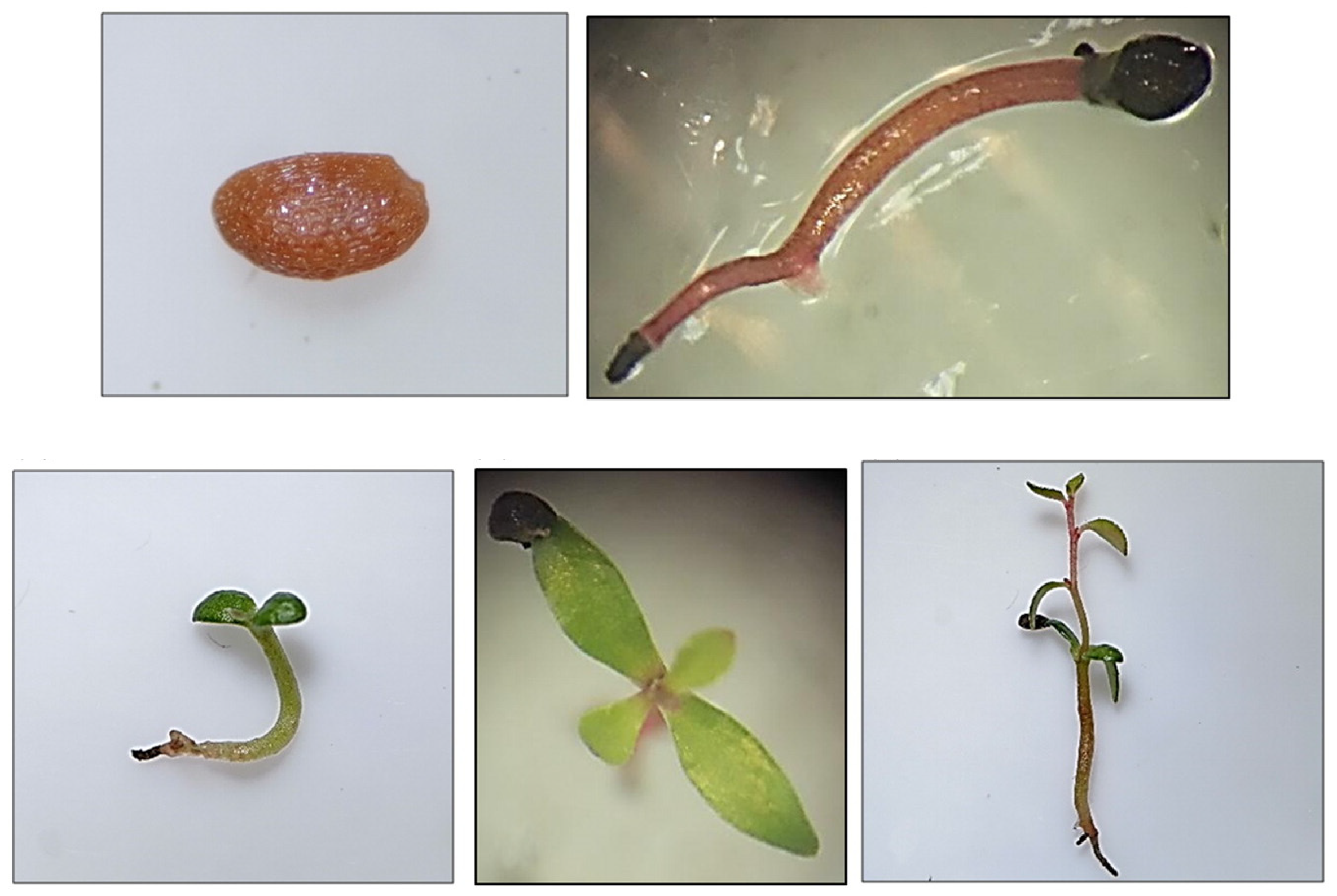
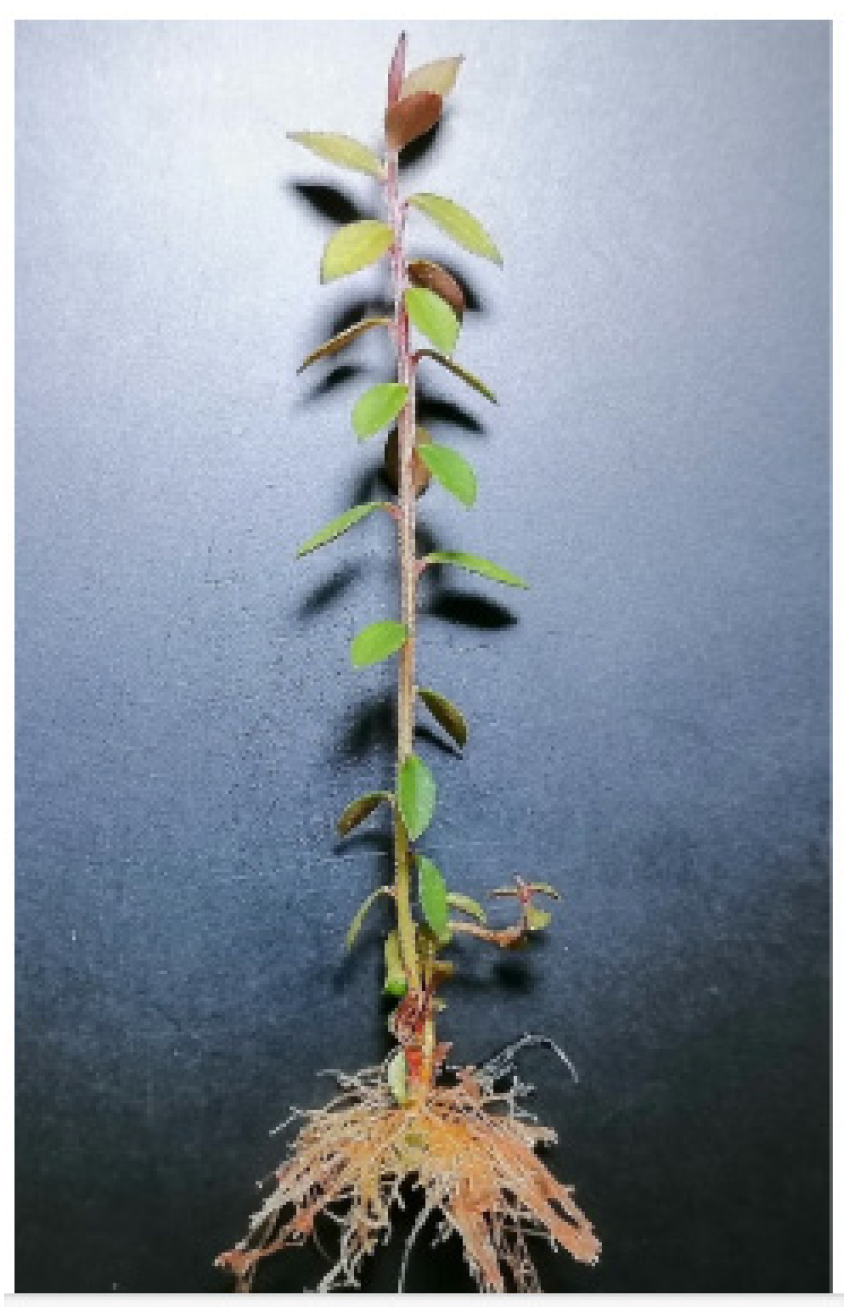
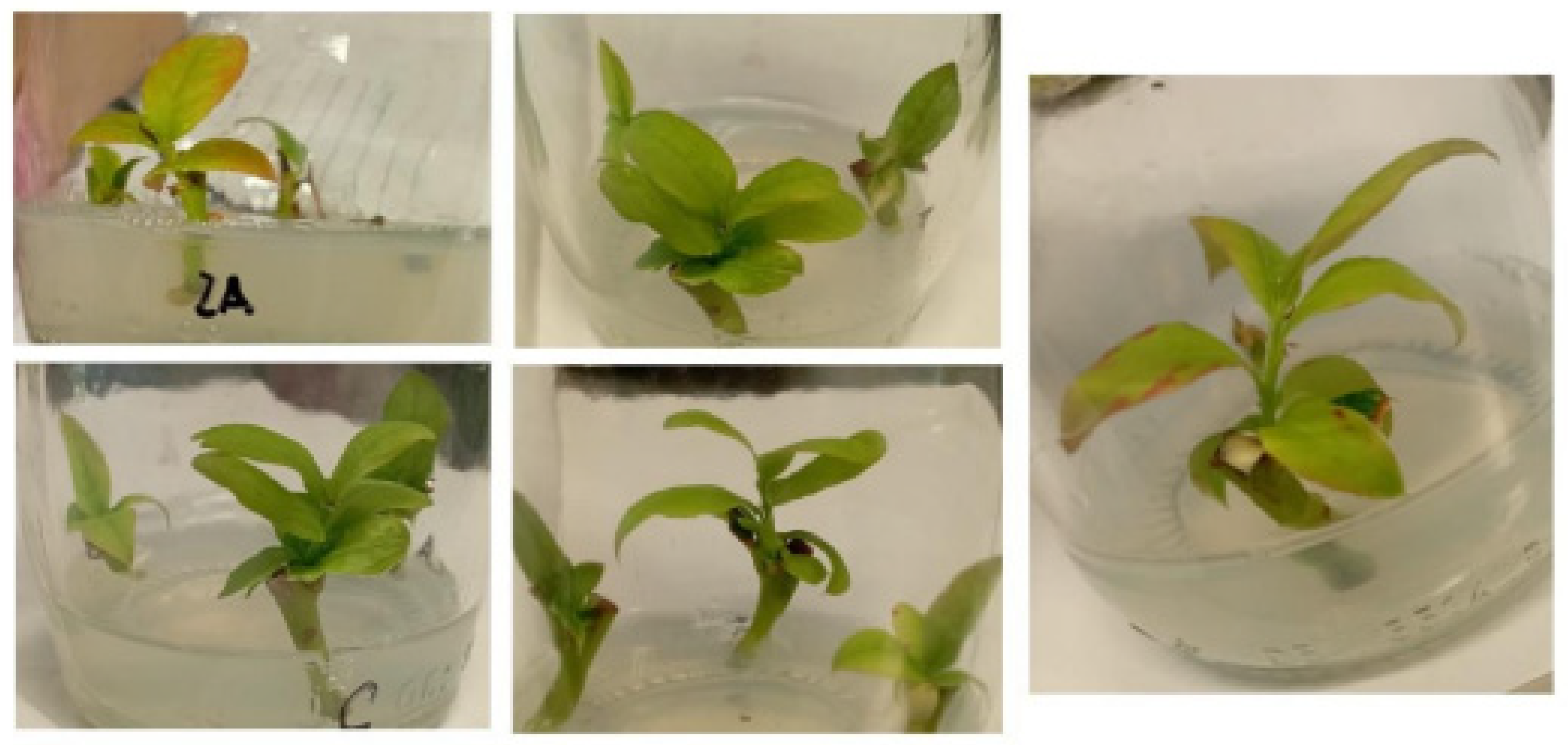
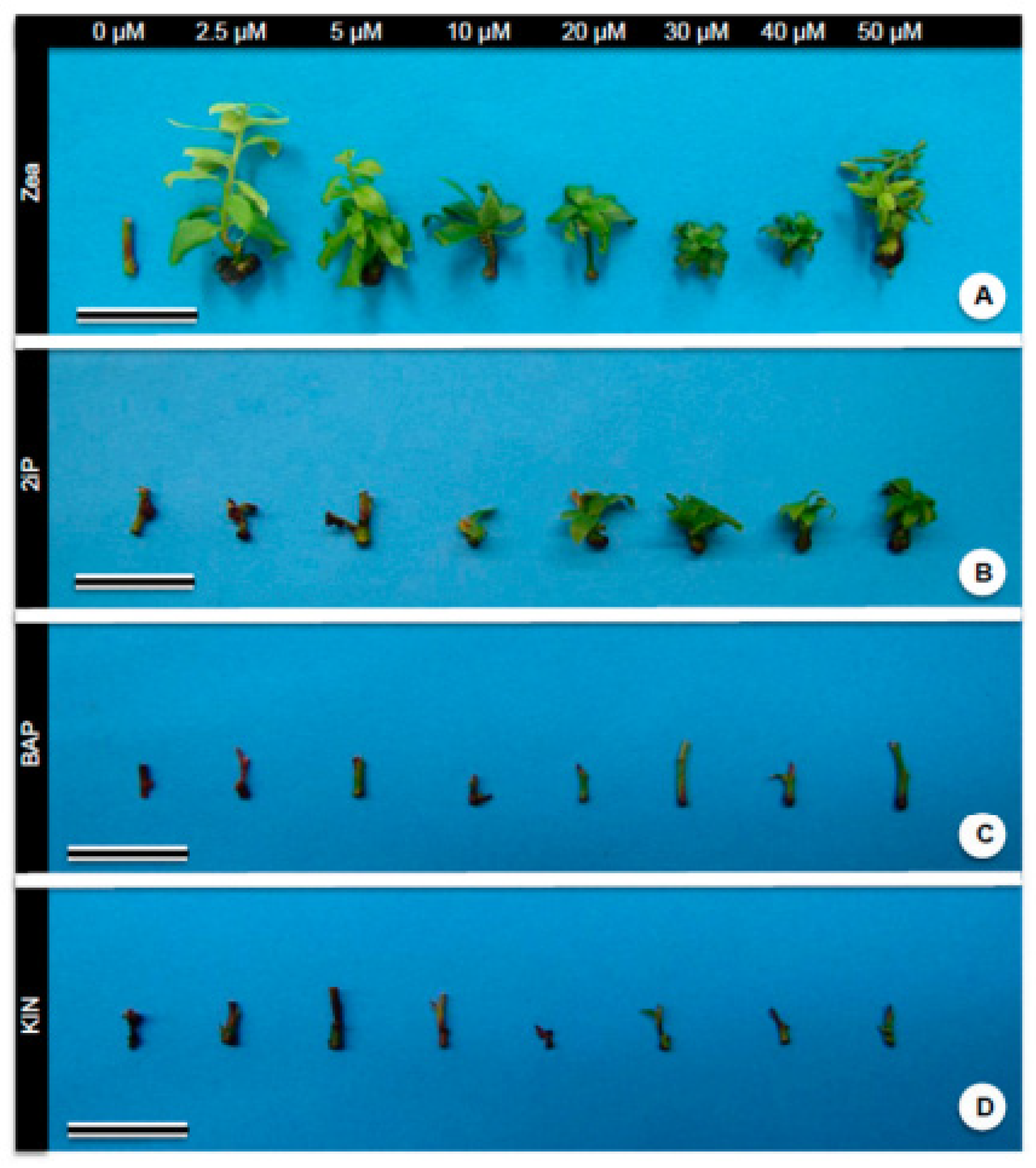
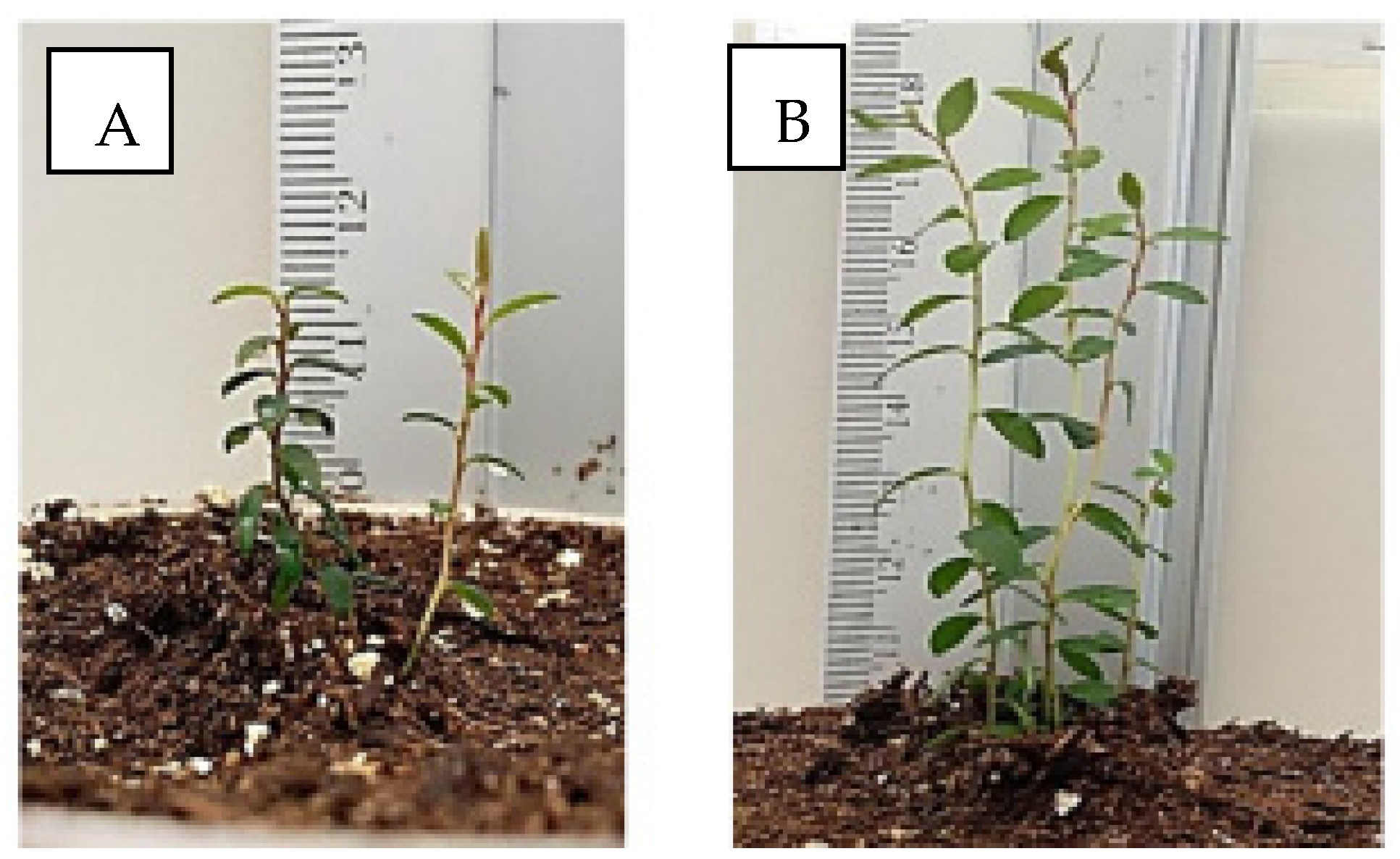
| Disinfection Agent | Time of Operation (minutes) | References |
|---|---|---|
| Ethanol 70% | 0.5 | [6] |
| 0.5% NaClO 1 with 0.1% with Tween 20 | 5 | |
| Ethanol 70% | 1 | [7] |
| Clorox 10% | 6 | |
| Ethanol 70% | 1 | [8] |
| NaClO diluted 1% with tap water | 20 | |
| 20% Clorox (1.2% NaClO) | 20 | [19] |
| Ethanol 70% | 0.2 | |
| Ethanol 70% | 2 | [41,42] |
| Mercuric chloride 0.1% with Tween | 6 | |
| Ethanol 75% | 0.5 | [40] |
| 4% NaClO | 15 | |
| Tween 20 | 30 | [43] |
| Ethanol 70% | 0.2 | |
| 0.1% HgCl2 2 | 8 |
| Media Culture | Sucrose (g/L) | Agar (g/L) | pH | References |
|---|---|---|---|---|
| WPM 1 | 20 | 6 | 5.2 | [4] |
| WPM | 30 | 6 | 5.2 | [6] |
| WPM | 15 | 5–6 | 5.0 | [8] |
| AN 2 or WPM | 30 | 8 | 5.0 | [19] |
| MW (MS 3 and WPM) | 30 | 8 | 5.0 | [19] |
| WPM | 20 | 7.5 | 4.9 | [53] |
| WPM | - | - | 4.2 | [62] |
| AN | 30 | 8 | 3.8 | [41] |
| M-WPM | 20 | 6 | 5.4 | [40] |
| AN | 30 | 8 | 4.5–5.5 | [42] |
| Growth Regulators | Concentrations (mg/L) | Stage of Micropropagation | References |
|---|---|---|---|
| Zeatin | 0.5–4.0 | In vitro proliferation | [4] |
| TDZ 1 | 1 | In vitro rooting | |
| NAA 2 | 0.5 | ||
| Zeatin | 0.6; 1.1 | In vitro initiation and proliferation | [6] |
| 2-iP 3 | 2.0; 4.1; 6.1; 8.1; 10.2 | ||
| BAP 4 | 6.8; 9.0; 11.3 | ||
| Zeatin | 1–5 | Leaf, meristem, and shoot proliferation | [7] |
| Zeatin | 0.5–1 | In vitro initiation | [8] |
| 2-iP | 4–10 | In vitro proliferation | |
| IBA 5 | 1 | In vitro rooting | |
| Zeatin | 1–2 | In vitro initiation and proliferation | [41] |
| 2-iP | 2.5–5 | ||
| 2-iP riboside | 2.5–5 | ||
| IAA 6 | 0.2–0.5 | ||
| IBA | 0.8 | In vitro rooting | |
| Zeatin | 2.5–5 | In vitro initiation and proliferation | [40] |
| TDZ | 0.0005 | ||
| IBA | 0.1 | ||
| Zeatin | 2 | In vitro regeneration and proliferation | [43] |
| 2-iP | 15 | ||
| TDZ | 0.2–0.5 | ||
| Zeatin | 3 | In vitro proliferation | [63] |
| 2-iP | 2 | ||
| IAA | 1 | In vitro rooting |
Disclaimer/Publisher’s Note: The statements, opinions and data contained in all publications are solely those of the individual author(s) and contributor(s) and not of MDPI and/or the editor(s). MDPI and/or the editor(s) disclaim responsibility for any injury to people or property resulting from any ideas, methods, instructions or products referred to in the content. |
© 2024 by the authors. Licensee MDPI, Basel, Switzerland. This article is an open access article distributed under the terms and conditions of the Creative Commons Attribution (CC BY) license (https://creativecommons.org/licenses/by/4.0/).
Share and Cite
Correia, S.; Matos, M.; Leal, F. Advances in Blueberry (Vaccinium spp.) In Vitro Culture: A Review. Horticulturae 2024, 10, 533. https://doi.org/10.3390/horticulturae10060533
Correia S, Matos M, Leal F. Advances in Blueberry (Vaccinium spp.) In Vitro Culture: A Review. Horticulturae. 2024; 10(6):533. https://doi.org/10.3390/horticulturae10060533
Chicago/Turabian StyleCorreia, Suzanna, Manuela Matos, and Fernanda Leal. 2024. "Advances in Blueberry (Vaccinium spp.) In Vitro Culture: A Review" Horticulturae 10, no. 6: 533. https://doi.org/10.3390/horticulturae10060533
APA StyleCorreia, S., Matos, M., & Leal, F. (2024). Advances in Blueberry (Vaccinium spp.) In Vitro Culture: A Review. Horticulturae, 10(6), 533. https://doi.org/10.3390/horticulturae10060533







